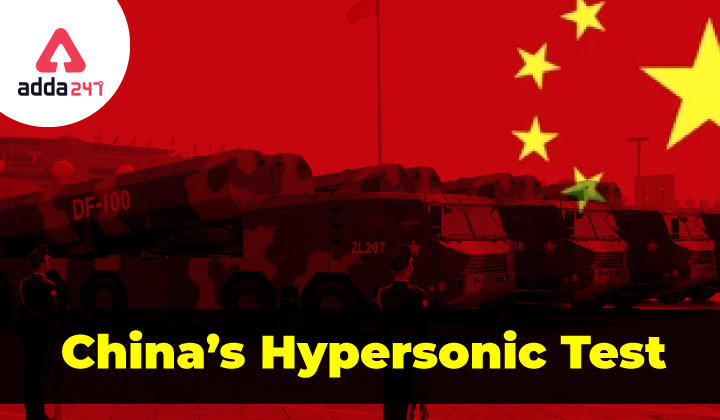GS Paper – 3: Defence Technology
Introduction:
- Recently, a hypersonic missile had been launched by China. It flew through low-orbit space before cruising down and narrowly missing its target.
- Hypersonic weapons travel in the upper atmosphere at speeds of more than five times the speed of sound, or about 6,200 kph (3,853 mph).
- Hypersonic weapons are strategic game-changers with the dangerous potential to fundamentally undermine the strategic stability of any Country.
What is a Hypersonic Glide Vehicle that China tested?
- China had in August tested a new hypersonic missile, which is nuclear-capable, which circled the earth before moving towards its target, missing it by two dozen miles.
- While China denied the report claiming it to be a “spacecraft” and not a missile, it demonstrated the capability in hypersonic glide vehicle technology,
- A hypersonic glide vehicle is launched by a rocket that moves in the Earth’s lower orbit, at more than five times to 25 times the speed of sound. The vehicle is capable of carrying nuclear payloads, which gives the launching country the strategic capacity to attack alm
 ost any target across the world.
ost any target across the world. - They fly at five times the speed of sound, slower than a ballistic missile. But they do not follow the fixed parabolic trajectory of a ballistic missile and are manoeuvrable, making them harder to track.
Which countries have hypersonic technology?
- The US, Russia and China are all developing hypersonic weapons, including glide vehicles that are launched into space on a rocket but orbit the earth under their own momentum.
- While this would be China’s first such test for the capability US military often flies an unarmed orbiter-glider, the X-37B spaceplane.
- According to the Rand Corporation’s 2017 report, France and India are the most committed to gaining the capability, and both draw to some extent on cooperation with Russia. Australia, Japan, and European entities are also working towards it.
- hypersonic technology has a dual-use character, as it can be used for non-military purposes like space launch and spacecraft retrieval, but once a nation acquires hypersonic technology, its intentions can change.
- The current situation, with hypersonic research openly disseminated and widely spread among governments, industries, and universities, presents challenges for non-proliferation.
What are the main concerns about China developing such technology?
- Though many of the targets that a hypersonic missile can hit are already reachable through the ICBMs, China’s almost successful test has given rise to a lot of anxiety to military powers the world over.
- Beijing continuously builds up its conventional military forces and engages in increasingly assertive military activity near Taiwan.
- China developing hypersonic missile capability would mean that it, potentially, would have weapons to overwhelm America’s aerial defence systems.
- But globally the main concern is that once the technology is successfully established by even one country, it would lead to a larger race for the capability and its eventual proliferation.
- A hypersonic attack could occur with very little warning time; this factor and the unpredictability of the targets of a hypersonic attack compress the timeline for response by the party being attacked.
- It’s a great matter of concern for India also as China is expanding rapidly—in space, in cyber and then in the traditional domains of land, sea and air.
What is the Agni 5 missile?
- Agni 5 is India’s long-range surface-to-surface ballistic missile, which can hit a target with a precision that is 5,000 km away.
- This range puts almost the entire China within the missile’s target range. Though officially an ICBM needs a missile to have a range of at least 5,500 km, the Agni 5 is India’s closest contender for an ICBM, as it can reach countries across other continents, including parts of Africa and Europe.
- Though the government has claimed that it has a maximum range of around 5,000 km, several reports suggest that it can hit targets as distant as 8,000 km. The nuclear-capable missile can carry a warhead of around 1,500 kg and has a launch weight of 50,000 kg, making it one of the most potent missiles in the country.



 TSPSC Group 1 Question Paper 2024, Downl...
TSPSC Group 1 Question Paper 2024, Downl...
 TSPSC Group 1 Answer key 2024 Out, Downl...
TSPSC Group 1 Answer key 2024 Out, Downl...
 UPSC Prelims 2024 Question Paper, Downlo...
UPSC Prelims 2024 Question Paper, Downlo...




